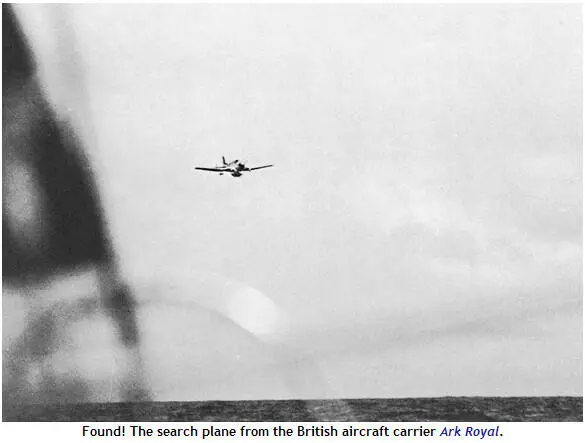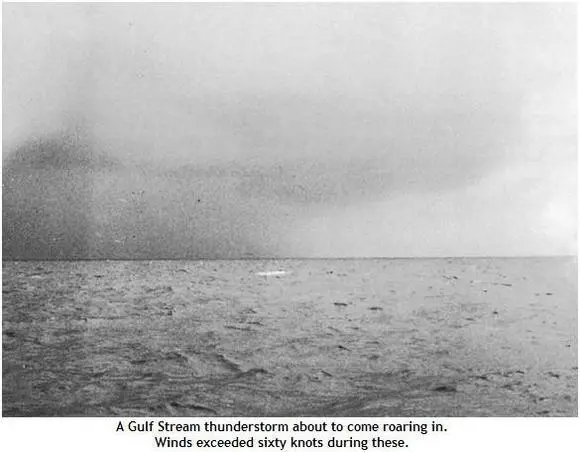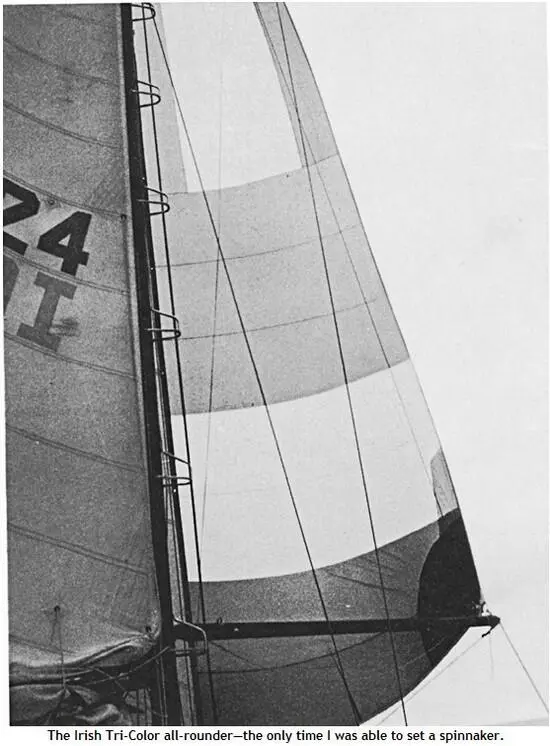

Fifteen minutes later, there was another, different sort of noise, and I opened my eyes to see a helicopter coming straight at us from the north. It occurred to me that although the first pilot had found me and I had waved, I had given him no indication of whether I needed help, so as the chopper passed I gave him a thumbs-up sign. Two crewmen, sitting in an open doorway aft, waved back, and they were off, back to the east again. I waited for a while longer in the cockpit, but the carrier never appeared. I knew, though, that I had been reported, for the first time in three weeks, and I was wildly elated.
I now found myself low on water. The fouled starboard tank was empty and the port tank was less than half full. There was only one bottle of beer left, too, but plenty of wine and food. I had begun to lose weight, now, the snack foods having run out, and I was in good health and excellent spirits. I expected to be in the Gulf Stream soon, and I began to read up on what Adlard Coles and Erroll Bruce had to say about sailing in that great ocean current. None of it was good. The current normally runs at one-half to one and one-half knots, according to the pilot chart, but what I was reading indicated that in places it could run three to five knots and even reverse its normal southwest to northeast direction. The very warm water temperatures caused very changeable weather conditions, too, and nobody seemed able to predict anything about the Gulf Stream.
On the eleventh, as I was cooking, I looked out and saw through the port window what looked like a big squall. There had been dark clouds down there all day, but we had been making good progress under shortened sail. I started on deck to have a better look, but stopped with one foot in the cockpit as a thunderstorm, complete with thunder and lightning, struck us. I have never seen anything like it. Visibility came to an end. The self-steering, about eight feet away, disappeared in a wall of gray water. The sea around the boat turned white, churned into foam by the force of the rain. I pulled my foot back inside the hatch and stood on the ladder and watched. I suppose it lasted for about two minutes, and then I was able to get into the cockpit and reef farther. I felt lucky that nothing had broken, and I figured it would all blow over as quickly as it had come. It did, but it came again and then again. I have never experienced anything as sudden and as violent as these thunderstorms which raked across us for two and a half days. On land there are trees and buildings to break the force of such storms, but not at sea. Even more frightening than the sixty-knot gusts of wind was the lightning. For the whole of the two and a half days I had the feeling of living under a huge, electrically lit sign which, because of some wiring fault, was flashing on and off erratically. It was all the more frightening because Harp ’s mast, thirty-eight feet above the water, was the only tall object in hundreds of square miles, and it was made of aluminum, a wonderful conductor of electricity.

Occasionally there was a lull, when the wind would drop to Force six or seven for a few minutes. During one of these, Fred tacked the boat and put us aback. He had done this several times, when the combination of a gust and a wave would push the boat up into the wind a bit, and I was extremely annoyed with him. I had always talked to him, as if he were a dog or cat, and now I found myself screaming at him as I struggled to get the boat back on the right tack in the big seas, “You sonofabitch! You do that again and I... I won’t oil you any more!”

About seven-thirty in the evening of the thirteenth the wind had dropped enough to unreef, and for the first time in what seemed like years, the horizon to windward was not filled with dark thunderheads. I released the reefing line to the Dynafurl and started to crank in on the sheet to shake out the reefing genoa, pleased because we were only about four hundred miles out of Newport now, and I was hoping to cross the line on Friday, the sixteenth. That would give me a reasonably creditable passage of forty days — more than I had wanted to take, but not bad. Something stuck. The sail would not come unreefed. Swearing under my breath, I hauled the sheet in as tight as it would go, made it fast, got into a harness, and crawled onto the foredeck, where I began turning the swiveled forestay by hand. Suddenly, the forestay wasn’t there anymore. There was a metallic thunking noise and the whole stay, sail and all, flew out of my hands, the aluminum reel at the bottom nearly hitting me in the face. I had been squatting, turning the stay, and now I was dumped back onto my bum, watching the forestay, which supported the mast from forward, waving the number-two genoa in the breeze from the top of the mast like a giant flag. First the stay, now the stick, I thought.
I sat on the foredeck and waited for the mast to go.
26
Drifting in the Gulf Stream
Incredibly, the mast did not break. The wind was down to about Force three, the main was double-reefed, and the inner forestay held everything together long enough for me to charge aft and release the main sheet and start getting halyards forward. Fortunately, Harp was equipped with two genoa halyards and two spinnaker halyards, and I got three of this lot forward to the toe rail and winched them tight. The mast would not fall now, but there was the immediate problem of recovering the flailing forestay and sail before the fitting at the top of the mast broke under the strain and sent everything overboard.
After twenty minutes of fruitless effort, trying to haul everything down onto the deck by hand, I discovered the easy way: I put the windward sheet onto one of the big Barlow self-tailing winches and cranked away until the stay was back on deck and under control. Perhaps “under control” is an overstatement, for the aluminum-rod forestay was writhing all over the place like a giant serpent. Finally, I got it shackled to the toe rail and lashed it so that it could not thrash about and chafe things. Next, I got the sail off, with some difficulty, and stowed. This gave me another genoa halyard to play with, and now the wisdom of having the little storm jib made came home to me. I set this flying on the halyard, tacked to the pad eye, which had been fitted about two feet abaft the forestay tack, and once again we had a headsail and could go to windward. We couldn’t point very high, but we could go to windward, and that’s where Newport was.
Trouble was, now that the wind had dropped and we had been reduced to a double-reefed main and a storm jib, we could move at only about two knots. I was afraid to hoist the whole main for fear of putting too much strain on the halyards and toe rail forward. Making two knots, there was no chance of reaching Newport by the weekend, and this was very depressing. Still, things could have been a great deal worse; we could have lost the mast and really have been in trouble. Our reduced speed called for a reassessment of the food and water situation, too. Food was getting short and water even shorter, so I had to be very careful to see that nothing else happened to delay us, or I would have to go on a very serious diet. I had already started brushing my teeth in salt water, and now I watched every drop. I tried collecting more water in the thundershowers by hanging a bucket from the end of the boom; this worked for a while, then the bucket blew away. But at least we had a main and a headsail and, above all, a mast.
Читать дальше
















